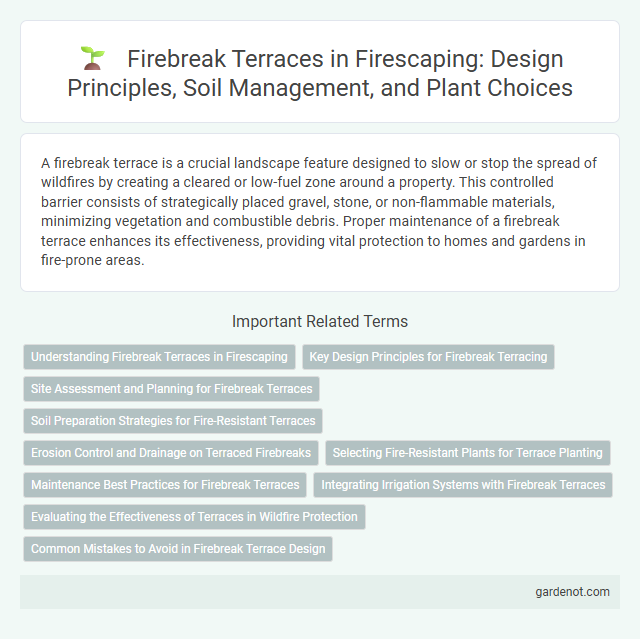A firebreak terrace is a crucial landscape feature designed to slow or stop the spread of wildfires by creating a cleared or low-fuel zone around a property. This controlled barrier consists of strategically placed gravel, stone, or non-flammable materials, minimizing vegetation and combustible debris. Proper maintenance of a firebreak terrace enhances its effectiveness, providing vital protection to homes and gardens in fire-prone areas.
Understanding Firebreak Terraces in Firescaping
Firebreak terraces serve as strategic vegetative or non-combustible barriers designed to slow or halt the spread of wildfires across sloped terrain. These terraces create clear zones by removing flammable materials and incorporating fire-resistant plants, effectively reducing fire intensity and providing safer pathways for firefighting efforts. Proper implementation of firebreak terraces is crucial in firescaping to protect homes and natural landscapes by disrupting the continuous fuel load on hillsides and terraces.
Key Design Principles for Firebreak Terracing
Firebreak terracing involves creating strategically designed terraces with non-flammable materials such as gravel or stone to interrupt the continuity of combustible vegetation. Key design principles include maintaining adequate width--typically 6 to 10 feet--to effectively slow or stop fire spread, ensuring proper drainage to prevent erosion, and incorporating low-growing, drought-resistant plants to reduce fuel load. The terraces should be positioned on slopes to create defensible spaces around structures, complying with local fire safety regulations and integrating with wider landscape fire management strategies.
Site Assessment and Planning for Firebreak Terraces
Site assessment for firebreak terraces involves analyzing topography, vegetation type, and prevailing wind patterns to optimize fire containment. Planning incorporates strategic placement of terraces to create effective fuel breaks that minimize wildfire spread while considering soil stability and erosion control. Integrating local fire behavior data ensures terraces are designed to maintain safety zones and protect structures.
Soil Preparation Strategies for Fire-Resistant Terraces
Soil preparation for fire-resistant terraces involves creating a well-drained, nutrient-rich base that minimizes flammable organic material. Incorporating fire-retardant soil amendments like gypsum and composted mulch improves moisture retention and reduces ignition risk. Strategic layering and regular soil aeration enhance root growth and overall terrace resilience against wildfires.
Erosion Control and Drainage on Terraced Firebreaks
Terraced firebreaks play a critical role in erosion control by stabilizing soil on slopes and reducing runoff velocity, which prevents soil displacement during heavy rains. Properly designed drainage systems integrated into firebreak terraces guide water safely away, minimizing erosion and maintaining the firebreak's integrity. Effective erosion control and drainage on terraced firebreaks enhance wildfire protection while preserving the landscape's stability and preventing sediment loss.
Selecting Fire-Resistant Plants for Terrace Planting
Selecting fire-resistant plants for a firebreak terrace involves choosing species with low flammability, such as succulents, lavender, and rosemary, which contain high moisture content and minimal volatile oils. Incorporating drought-tolerant native plants enhances fire resistance by reducing fuel load and maintaining soil stability. Proper plant spacing and maintenance further minimize fire spread risk, creating an effective barrier against wildfires.
Maintenance Best Practices for Firebreak Terraces
Regular inspection and removal of dry vegetation on firebreak terraces are essential maintenance practices to prevent fuel buildup and reduce wildfire risk. Implementing soil stabilization techniques such as mulching or planting drought-resistant ground covers helps maintain terrace integrity and minimizes erosion. Scheduling maintenance activities before peak fire season ensures firebreak terraces remain effective barriers against advancing wildfires.
Integrating Irrigation Systems with Firebreak Terraces
Integrating irrigation systems with firebreak terraces enhances wildfire protection by maintaining moisture levels in critical vegetation zones, reducing flammable plant growth. Efficient drip or sprinkler irrigation tailored to firebreak terraces supports plant health while minimizing water waste. Strategic water management within these terraces creates a controlled landscape buffer that slows fire spread and improves fire resilience.
Evaluating the Effectiveness of Terraces in Wildfire Protection
Firebreak terraces serve as critical barriers that slow or halt wildfire spread by removing flammable vegetation and creating defensible space. Research indicates that well-maintained terraces with adequate width and clear vegetation can reduce fire intensity and provide strategic access for firefighting efforts. Evaluating firebreak terraces involves assessing their design, maintenance frequency, and integration with other landscape fire management practices to maximize wildfire protection efficacy.
Common Mistakes to Avoid in Firebreak Terrace Design
Common mistakes in firebreak terrace design include failing to maintain adequate width and vegetation clearance, which reduces the effectiveness of the fire barrier. Overlooking soil erosion control can lead to unstable terraces that compromise firebreak integrity. Neglecting regular maintenance, such as removing dead plant material and debris, increases the risk of fire spread despite the presence of the firebreak.
Firebreak terrace Infographic

 gardenot.com
gardenot.com